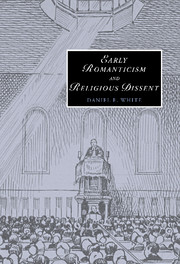Book contents
- Frontmatter
- Contents
- List of illustrations
- Acknowledgments
- Frequently cited texts
- Epigraph
- Introduction
- 1 “True Principles of Religion and Liberty”: liberal Dissent and the Warrington Academy
- 2 Anna Barbauld and devotional tastes: extempore, particular, experimental
- 3 The “Joineriana”: Barbauld, the Aikin family circle, and the Dissenting public sphere
- 4 Godwinian scenes and popular politics: Godwin, Wollstonecraft, and the legacies of Dissent
- 5 “Properer for a Sermon”: Coleridgean ministries
- 6 “A Saracenic mosque, not a Quaker meeting-house”: Southey's Thalaba, Islam, and religious nonconformity
- 7 Conclusion
- Notes
- Bibliography
- Index
- CAMBRIDGE STUDIES IN ROMANTICISM
7 - Conclusion
Published online by Cambridge University Press: 22 September 2009
- Frontmatter
- Contents
- List of illustrations
- Acknowledgments
- Frequently cited texts
- Epigraph
- Introduction
- 1 “True Principles of Religion and Liberty”: liberal Dissent and the Warrington Academy
- 2 Anna Barbauld and devotional tastes: extempore, particular, experimental
- 3 The “Joineriana”: Barbauld, the Aikin family circle, and the Dissenting public sphere
- 4 Godwinian scenes and popular politics: Godwin, Wollstonecraft, and the legacies of Dissent
- 5 “Properer for a Sermon”: Coleridgean ministries
- 6 “A Saracenic mosque, not a Quaker meeting-house”: Southey's Thalaba, Islam, and religious nonconformity
- 7 Conclusion
- Notes
- Bibliography
- Index
- CAMBRIDGE STUDIES IN ROMANTICISM
Summary
“It is as impossible to establish an unity of religious opinion, as it is for man to regulate the great movements of the ocean,” wrote Benjamin Bousfield in 1791. Early Romanticism arose during an era in which literary innovations and political identities were shaped by diverse currents of belief and practice, by waves of religious opinion. Impelled by heterogeneous doctrines, tastes, interests, and ideologies, individuals formed themselves into sectarian, denominational, non-denominational, and established societies, assuming a series of correspondent personal, social, and aesthetic perspectives. The variety and popularity of religious writing during the early Romantic period suggest that to many, including the range of figures that this book has considered, efforts to comprehend the natures of and relationships between individuals, communities, and God played complex and crucial roles in the development of publicly oriented literary and political programs.
The meaning of religious organization itself provided a conflicted field of debate and representation through which early Romantic writers understood themselves and their work. If during the late eighteenth century many nonconformist writers associated themselves with liberal Dissenting denominations whereas others, especially lapsed Anglicans, embraced either non-denominational or anti-sectarian varieties of nonconformity, early-nineteenth-century literary culture saw a steady diminution of the former, denominational mode. As liberal Dissent gave way to Methodism, Evangelicalism, and the missionary movement, and as the progress of the French Revolution and the Revolutionary War drove England into a period of political and religious retrenchment, the public viability of denominational or sectarian identities dwindled in the minds of many heterodox nonconformist writers, and so did the possibilities of literary affiliations explicitly rooted in the values and interests of these clearly defined religious organizations.
- Type
- Chapter
- Information
- Early Romanticism and Religious Dissent , pp. 182 - 187Publisher: Cambridge University PressPrint publication year: 2007



